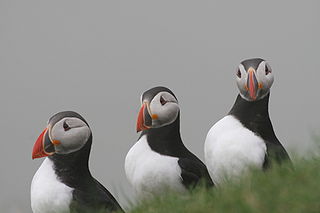
Faroese puffin
Encyclopedia

Faroe Islands
The Faroe Islands are an island group situated between the Norwegian Sea and the North Atlantic Ocean, approximately halfway between Scotland and Iceland. The Faroe Islands are a self-governing territory within the Kingdom of Denmark, along with Denmark proper and Greenland...
, in the North Atlantic Ocean
Atlantic Ocean
The Atlantic Ocean is the second-largest of the world's oceanic divisions. With a total area of about , it covers approximately 20% of the Earth's surface and about 26% of its water surface area...
. Atlantic Puffin
Atlantic Puffin
The Atlantic Puffin is a seabird species in the auk family. It is a pelagic bird that feeds primarily by diving for fish, but also eats other sea creatures, such as squid and crustaceans. Its most obvious characteristic during the breeding season is its brightly coloured bill...
s breed in the islands in large numbers, notably on Mykines
Mykines
Mykines is the western-most of the main 18 islands in the Faroe Islands. See also the only settlement on the island, Mykines.Only 11 people live in village Mykines all year around. The oldest inhabitant is 75 and the youngest is 6 years old....
, and from July, after the breeding season, it is legal to catch them for food. Puffins are also widely harvested and eaten in Iceland
Iceland
Iceland , described as the Republic of Iceland, is a Nordic and European island country in the North Atlantic Ocean, on the Mid-Atlantic Ridge. Iceland also refers to the main island of the country, which contains almost all the population and almost all the land area. The country has a population...
, especially in the Westmen Isles.
Puffin harvesting


Biomass (ecology)
Biomass, in ecology, is the mass of living biological organisms in a given area or ecosystem at a given time. Biomass can refer to species biomass, which is the mass of one or more species, or to community biomass, which is the mass of all species in the community. It can include microorganisms,...
of 3,000 tonnes. Seabird harvesting in the Faroe Islands has been carried out sustainably
Sustainability
Sustainability is the capacity to endure. For humans, sustainability is the long-term maintenance of well being, which has environmental, economic, and social dimensions, and encompasses the concept of union, an interdependent relationship and mutual responsible position with all living and non...
for at least 300 years, historically forming a very important component of the Faroese diet. Bag limits are now set each year to maintain the harvest of tens of thousands of birds annually. Ownership of the areas where puffins, and other harvested seabirds, breed and are caught, may be by individuals or communally by villages. Puffins and fulmars
Northern Fulmar
The Northern Fulmar, Fulmarus glacialis, Fulmar, or Arctic Fulmar is a highly abundant sea bird found primarily in subarctic regions of the north Atlantic and north Pacific oceans. Fulmars come in one of two color morphs: a light one which is almost entirely white, and a dark one which is...
are the most important species harvested, but guillemots
Common Guillemot
The Common Murre or Common Guillemot is a large auk. It is also known as the Thin-billed Murre in North America. It has a circumpolar distribution, occurring in low-Arctic and boreal waters in the North-Atlantic and North Pacific...
and gannets
Northern Gannet
The Northern Gannet is a seabird and is the largest member of the gannet family, Sulidae.- Description :Young birds are dark brown in their first year, and gradually acquire more white in subsequent seasons until they reach maturity after five years.Adults are long, weigh and have a wingspan...
(and, historically, other species) are also taken.
Puffins are caught by the traditional method of "fleyging". This is catching the birds in flight by actively netting them with the hand-wielded "fleygingarstong", a 3.6 metre-long pole with a small net at the end suspended between two rods, somewhat like a very long lacrosse stick
Lacrosse stick
A lacrosse stick or crosse is a long-handled racket used to play the sport of lacrosse. Players use the lacrosse stick to handle the ball and to strike at opposing players...
. Fleyging is usually carried out on a cliff-top from a "fleygises", or fleyging-seat, built of stones in a small depression so that the fleyger is concealed from overflying puffins. Several hundred puffins may be caught in this way by one person in a day.
Puffins in Faroese culture
Puffins are culturally important in the Faroe Islands. The Faroese word for puffin is "lundi". A popular and much loved Faroese cartoon character is the bespectacled puffin known as Ludvik Lundi.Puffin cuisine
The birds are traditionally prepared by being skinned, the feet, wings and internal organs removed, soaked in a simple marinade of saltwater, milk or ale, browned in a pan and then boiled. They are sometimes just smoked before being boiled. More recently other methods, such as grilling the breasts, are being used. Puffins may also be stuffed with sweet cake dough, raisins and spices, before being boiled or roasted.

